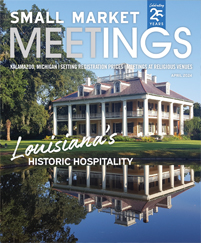Texas has always been big and bold, a blending of cultures based on who lived in the area when the Spanish first arrived and who owned the land moving forward. Texas was part of Mexico for 15 years and its own Republic from 1836 to 1845.
To add a taste of old Texas to your next Lonestar State gathering, consider holding events and meetings in some of these historically significant sites across the state.
Magoffin Home State Historic Site
El Paso
The 19-room adobe Magoffin Home was built in 1875 by a man who held the post of El Paso’s mayor four times. Joseph Magoffin, the grandson of Irish immigrants who had a Spanish mother, held many jobs in Texas, including justice of the peace, tax collector and vice president of a bank. What makes the home special is that there aren’t many old adobe homes left in the area from the late 1800s.
When the Magoffin Home was built, “everything in El Paso was adobe,” said Jeff Harris, manager of the historic site. “The railroads arrived in 1881, and people stopped building in adobe. They started building with fired brick. Magoffin is one of the few homes that predate the railroad in El Paso. Having an adobe house museum is kind of odd. That is one of the fun, unique things about our place.”
The Magoffin family lived in the home for more than 100 years. Groups can rent the home’s courtyard and two acres of property for events of 50 to 200 people. They also can rent the visitors center across the street for small group meetings. Group tours of the Magoffin Home and museum can be organized during planned events.
The home, which became a museum in the 1970s, sits in a historic neighborhood and historic district in El Paso and is surrounded by 30 museums and “gorgeous desert landscape,” Harris said.
www.thc.texas.gov/historic-sites
La Posada Hotel
Laredo
The La Posada Hotel has a long history in one of the oldest cities in Texas. It was built around four historic buildings on San Agustin Plaza, which dates to the late 1700s when the king of Spain asked his nobles to explore and settle the area between Tampico, Mexico, and the San Antonio River in Texas. Don Tomas Sanchez founded Villa San Agustin de Laredo on the north bank of the Rio Grande River in 1755.
La Posada was built on a site that served as the former town hall and jail and the first incarnation of Laredo High School. Those buildings were torn down in 1916, and the new high school was built. It also served as an elementary school but was converted to a hotel in 1961.
The high school building serves as the main entrance to the hotel and houses the Zaragoza Grill, meeting rooms, the Phillip V Ballroom and the Tesoro Club. The hotel’s ballrooms once served as a 19th-century convent, and the Capitol of the Republic of the Rio Grande building dates back to the 1830s and houses a museum on the hotel grounds. The hotel’s steakhouse is in a former residence that was built in 1883.
The hotel, with 206 rooms, has more than 15,000 square feet of flexible meeting space that can be used for conventions, banquets, social events, weddings and receptions. It can host events for 10 to 400 people.
Heritage Village at Chestnut Square
McKinney
Heritage Village got its start because the Heritage Guild of Collin County wanted to save two historic homes from demolition back in 1973. The group raised money to purchase the two homes by hosting historic home tours in the area. The village now covers two city blocks and includes historic homes, a chapel, a schoolhouse, a general store, a blacksmith shop, a smokehouse, a reception house and gardens.
“We have three tour houses indigenous to the property and another one on another block,” said Jaymie Pedigo, executive director of Heritage Village at Chestnut Square. The village also has two 1920s bungalows: one that serves as office space and one that is a reception hall.
Many locations on the property can be rented for events. The chapel can seat 125 people, and the reception house can seat 72. The Dulaney House, which was built in 1916 and was one of the first homes saved on the property, has three rooms on the first floor that can be used for small dinner parties of about 40 people. An on-site coordinator helps groups set up events and plan the menus with off-site caterers. The courtyard seats up to 125 people for dinner, and the property has a lot of undeveloped space that can be used for outdoor barbecues and fun team-building activities.
Heritage Village hosts numerous festivals and events throughout the year, and groups can set up private tours of the village or take a trolley tour of McKinney’s downtown historic district.
Opal Lawrence Historical Park
Mesquite
Opal Lawrence Historical Park sits on 13 acres in Mesquite. The three-story home, which was built in 1874 in Texas Prairie style, is in the same condition as when it was built. It has 14 rooms that were built before 1882 and a kitchen and tower that were added between 1886 and 1900. Outbuildings include a smokehouse, a brick-lined root cellar, a wash house, a large livestock barn and a mule barn.
When Stephen Decatur Lawrence was building the home, it was outside Mesquite.
“We think some of his style he brought from Tennessee when his father came here from Tennessee,” said Charlene Orr, manager of historic preservation for the city of Mesquite. “The barn, for instance; it is unique to have a plain livestock barn here.”
The family lived on the property from 1874 until they donated part of it to the city of Mesquite in 1996.
The furnishings in the home are original to the family, and visitors are invited to tour the historic property. The home is recognized as a Century Family Farm by the Texas Department of Agriculture. A nature trail runs behind the house and is used as an outdoor classroom through the Arbor Day Foundation. The historical park includes a small three-acre property in North Mesquite that has a Victorian farmhouse on it that is used for weddings and other events. The barn on the main property is rented out for receptions and lunches. It can hold between 60 and 100 people, depending on how it is set up.
National Ranching Heritage Center
Lubbock
At Texas Tech University, the National Ranching Heritage Center is a 44,000-square-foot museum and a 19-acre historic park with 50 authentic ranching structures dating from 1780 to the 1950s.
“Although there are ranches in every state of the nation, we assembled structures that were primarily chosen to represent the birth, growth and maturity of ranching in the region west of the Mississippi River, just as Colonial Williamsburg represents the nation’s history east of the river,” said Sue Hancock Jones, coordinator of outreach and communications for the center.
The center, which gets about 64,000 visitors a year, is owned by Texas Tech University and the Ranching Heritage Association.
Groups come to the center not only to learn more about the heritage of ranching in the area but also to host events. The site is famous for its chuck-wagon dinners, which can serve 150 people. The catering company uses metal Dutch ovens to make homemade biscuits in the ground, and the coffee is brewed over an open fire. Chuck-wagon breakfasts are also available.
“Ranch people feel strongly about their history,” Jones said. “That’s why they support us like they do. There’s ranching everywhere. Cowboys are real. I run into them all the time.”











